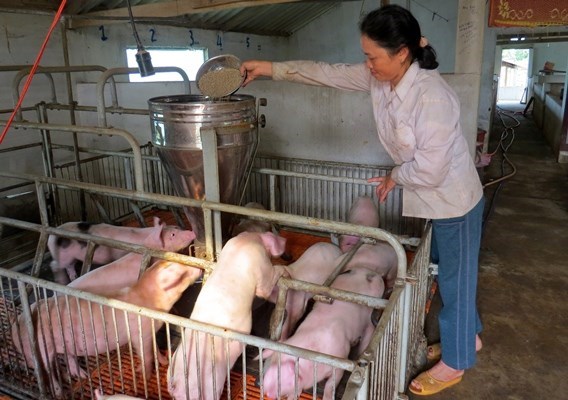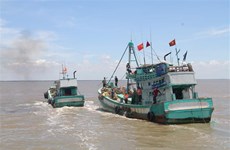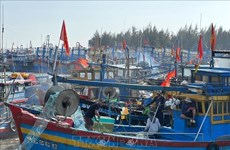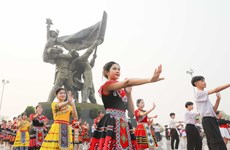Central Highlands tackles poverty with livestock
Hope may be the best motivation for impoverished residents who are striving to improve their lives in the Central Highlands at a time when Government efforts to support the change are continuing.
 Illustrative image (Source: VNA)
Illustrative image (Source: VNA)A field trip, which was organised by the Ministry of Planning and Investment's central coordinating committee for the Central Highlands Poverty Reduction Project, revealed the progress of the ongoing programme last December.
The project aims to enhance the opportunities and livelihoods of residents in poor households and communities in the highlands region by improving access to basic services related to farm production and strengthening food security and nutrition. It also helps them upgrade infrastructure and build the capacity of local staff.
The ministry plans to carry out the project from 2014 to 2019, with an investment of 165 million USD from the World Bank's official development assistance (ODA) and the State budget.
It expects the project to benefit about 540,000 people in 130 communes in 26 districts of six provinces, including Dak Lak, Dak Nong, Gia Lai, Kon Tum, Quang Nam and Quang Ngai.
More than a year after its implementation, the central coordinating committee of the project said in a news release last December that as of October 31, the project directly benefited more than 8,000 residents. However, the project is still on track to reach its target.
Dinh Thi Hue, 28, the mother of one child in Lang Tra hamlet in Quang Ngai's Son Cao commune, received a 19 million VND (844 USD) cow from the project and was taught by project staff how to breed it in a shed instead of letting it wander. She said she would keep it for hybridisation and hopes for a higher income in the future.
Another villager, Dinh Xuan Phang, said about 45 percent of the approximately 330 households in Lang Tra were identified as poor by authorities, with each household earning 400,000 VND (18 USD) or less per month.
While only some households received cows, Phang said, "Currently, we are not yet able to calculate the effect. But villagers expect that when the cows breed and by selling calves, they will have more money to pay for their children's studies and their families' living."
He added that a cow usually gives birth to a calf once a year, and a three-month-old calf can cost 10 million VND to 15 million VND (444 USD to 667 USD).
In the commune of Quang Ngai, Son Linh, 29-year-old Dinh Phu hopes that cow breeding will yield higher incomes in order to feed his three-year-old child. The father said his family finds it difficult to make ends meet just by growing cassava, earning only 2 million VND to 3 million VND (89 USD to 133 USD) from a crop that yields three to four tonnes per year.
In Krong Na commune of Dak Lak's Buon Don district, H'Nang Buon Gia said she was supported by the project during a rice crop that began late last August. The assistance related to seeds, fertilisers and cultivation techniques helped increase the harvest capacity on her field from five tonnes per 1,000sq.m to eight tonnes per 1,000sq.m by the end of last year.
She said the increase was quite significant because she had a 2,000sq.m field and rice could be sold at 3,500 VND (16 US cents) per kilogramme. However, the farmers still face many farming difficulties due to a lack of irrigational systems, and they must cope with inadequate rainfall and calcified wells of water.
Gia was one of 10 women from the M'Nong and E De ethnic groups in the commune who received support last year to improve nutrition and food security for their families, all of which are poor or nearly poor and have small children.
These farmers typically grow two to three crops a year, and they received assistance amounting to more than 36 million VND (1,600 USD) for a combined cultivating area of 2ha during the last crop. Despite that, they were still short on food.
"In every crop, each of our households produces about 10 rice bags that are enough for us to eat in two to three months only," one of the farmers said. "So in addition to our own field work, we often have to work for somebody else to get by. We just take each day as it comes."
H'Khiep Kpor of Dak Lak's EaWer commune appeared to be more optimistic. Her household was among 15 that received 450 chickens from the project in late July, and the flock was growing well. But she wished that more villagers would be supported through their hardships, since the majority of households in the commune are living in poverty.
The project's reach has expanded to include greater efforts from the Government and the community to help the region.
Victoria Kwakwa, the World Bank's Country Director for Vietnam, said in the news release in December that it is vital to pay more attention to addressing poverty in the region so that it can catch up with other parts of the country.
In 2013, a feasibility study report for the project pointed out that about 74 percent of Central Highlands ethnic minorities lived below the poverty line, while the poverty rate here reached nearly 33 percent, one of the highest in the country based on the Vietnam Household Living Standards Survey from 2010.
The Government said it prioritised efforts to improve minorities' lives and promote the Central Highlands' socio-economic development, and would stay committed to these issues going forward. However, the region received only about 4 percent of the total ODA in the country over the past two decades.
As of 2012, the region attracted ODA worth 193 million USD, with about 73 million USD disbursed, according to the report.
During the last December trip, Ministry of Planning and Investment official Tran Ngoc Hung, who directed the central coordinating committee, said limited experience of local authorities in managing ODA remained an obstacle in carrying out the ongoing project.
Improving awareness and knowledge of minorities in remote areas regarding poverty reduction is an ongoing challenge to those pursuing the process, Hung added.
"Persuading the residents to change their customs is the most difficult thing. They are familiar with small-scale production with low outcomes," said Nguyen Ngoc Vu Linh, 27, a community facilitator responsible for Quang Ngai's communes.
Linh is one of 130 facilitators who directly mobilise and guide residents to take part in project activities across the Central Highlands. He said it is important to teach the residents how to manage their households and assist their co-villagers for sustained poverty reduction.
After finishing a construction study at Duy Tan University in the central city of Da Nang in 2012, the young facilitator is now back in his native land, frequently travelling 70km a day by motorbike through mountainous terrain to do the job.
"I want to lend a hand to build my homeland and I feel this job is meaningful," he said. "My colleagues and I meet quite a lot of difficulties in doing this, but none of us ever intend to give up.".-VNA













